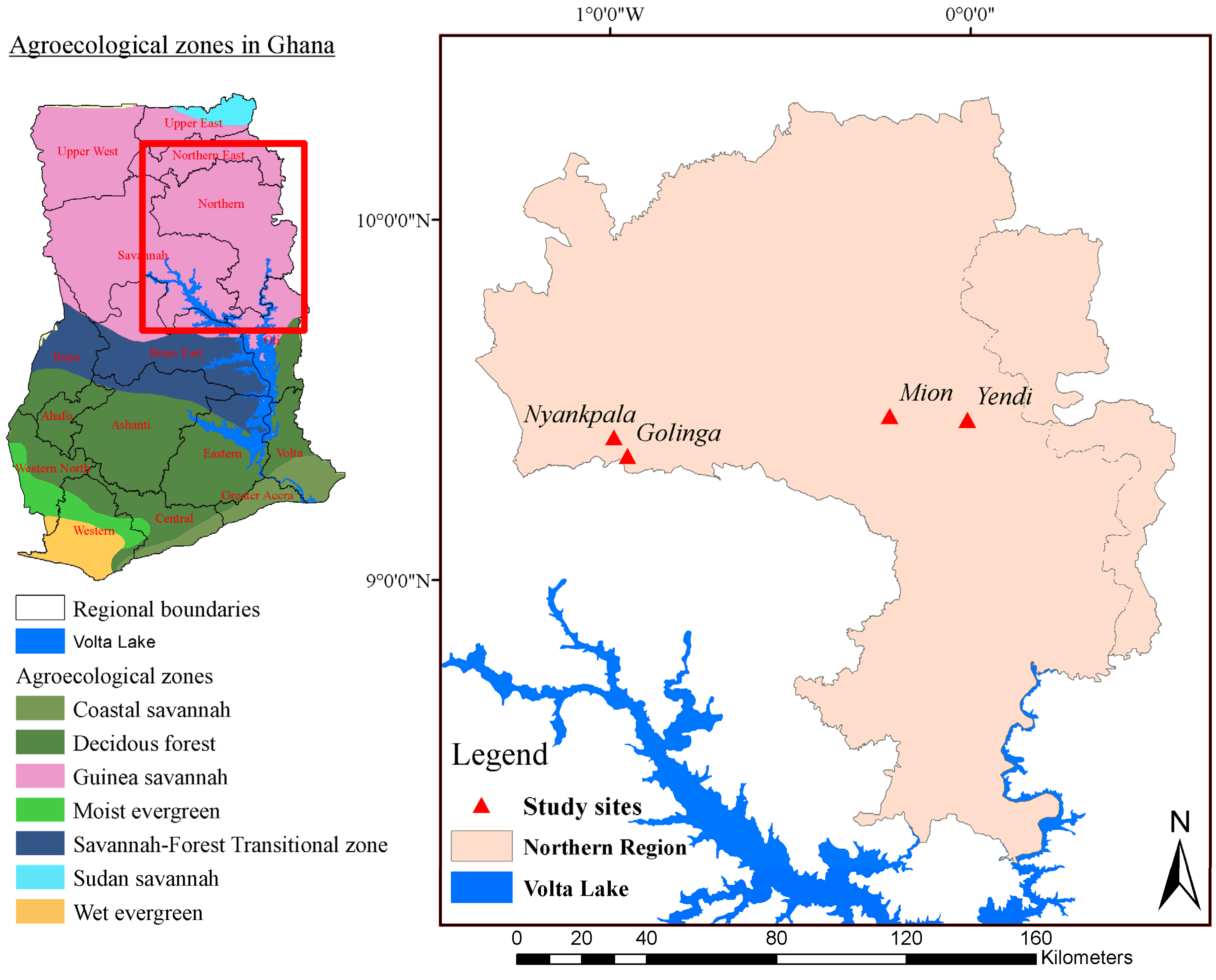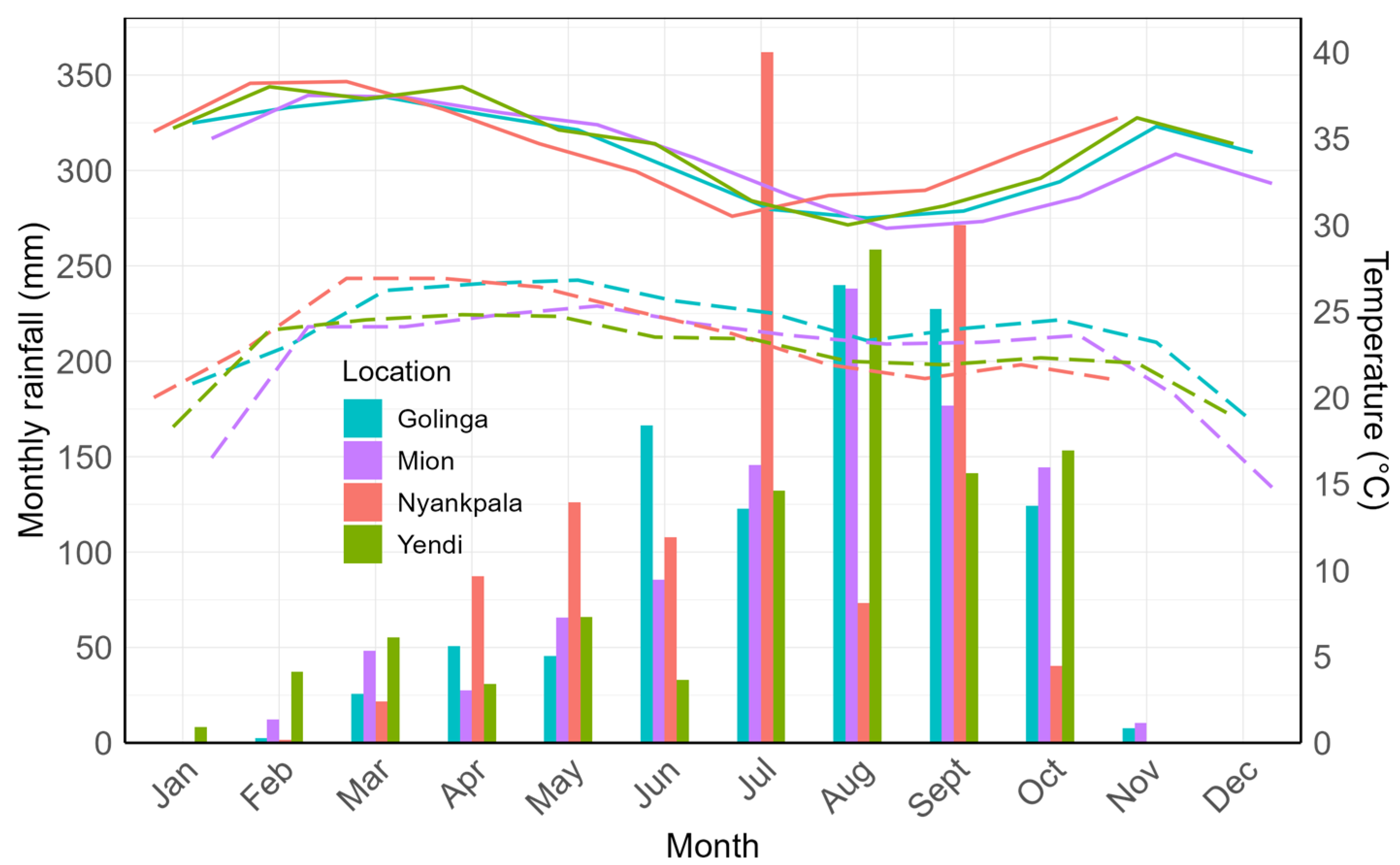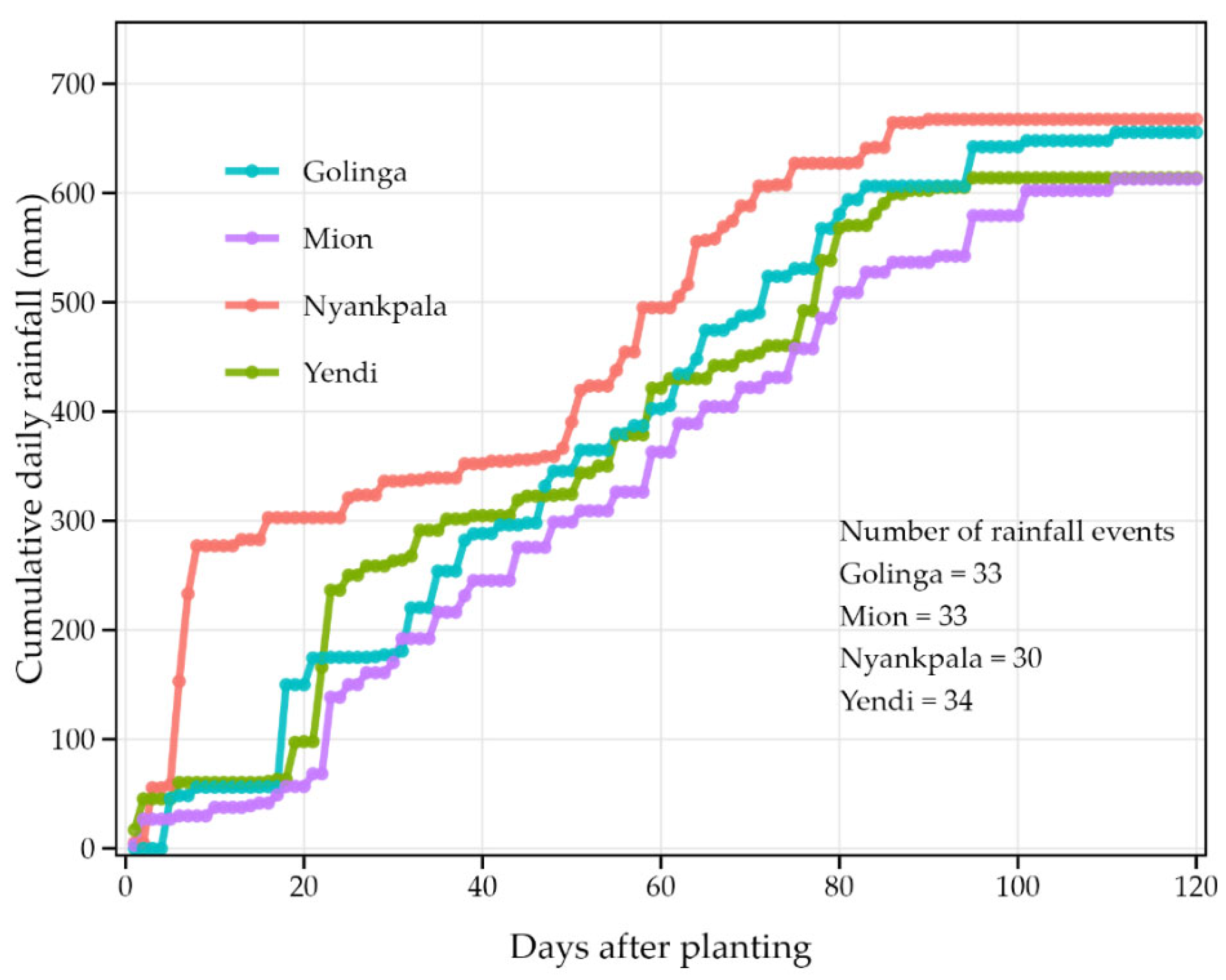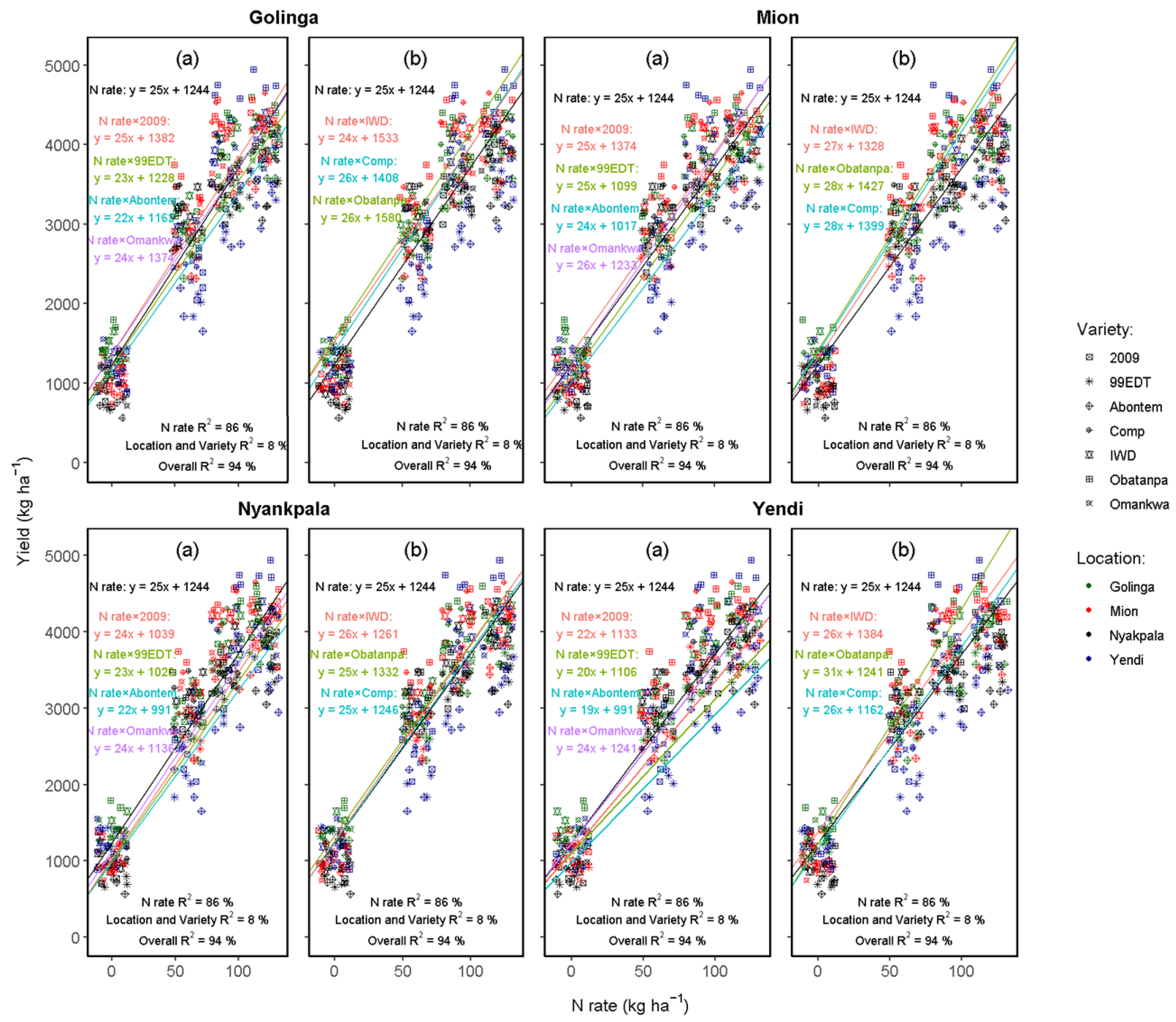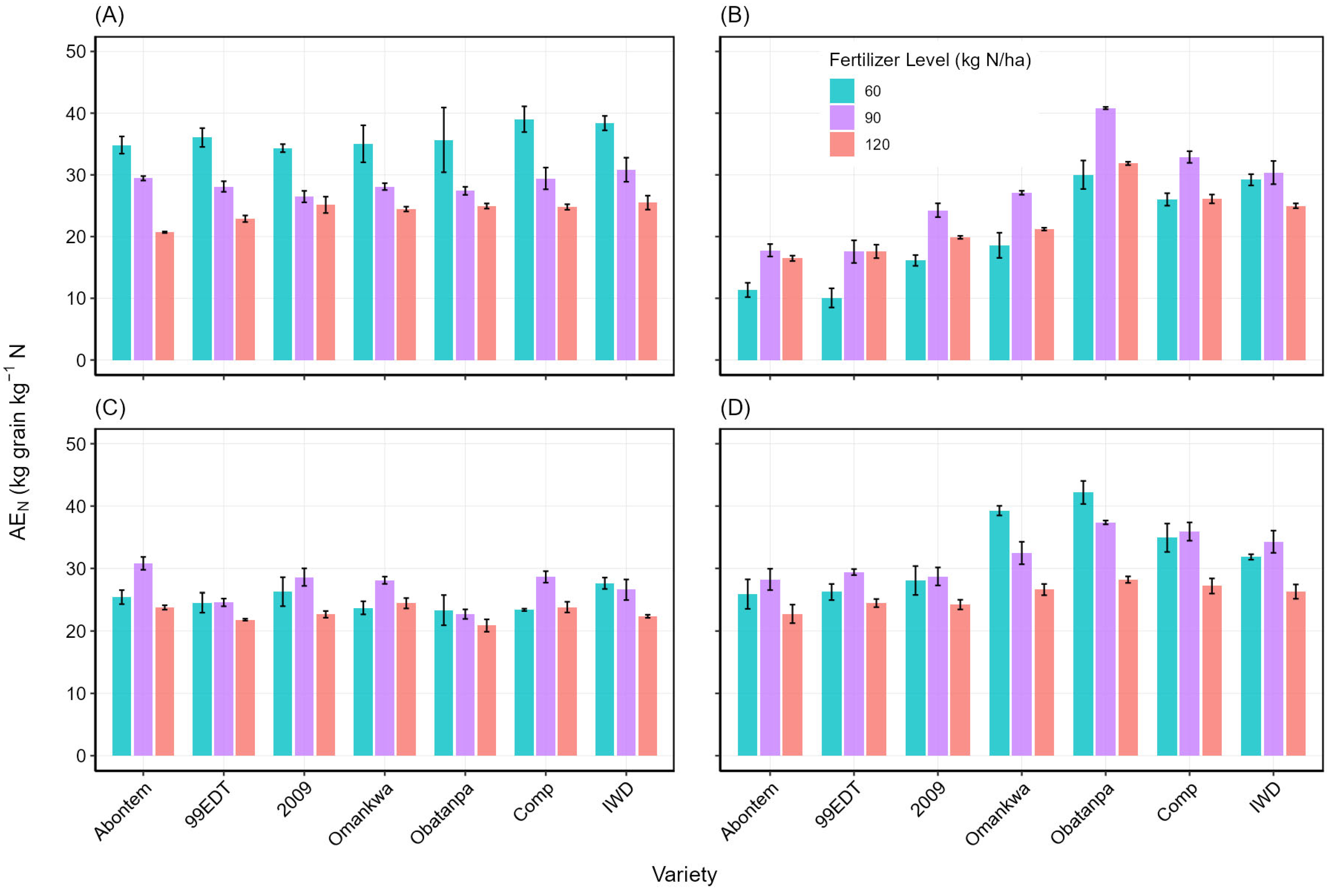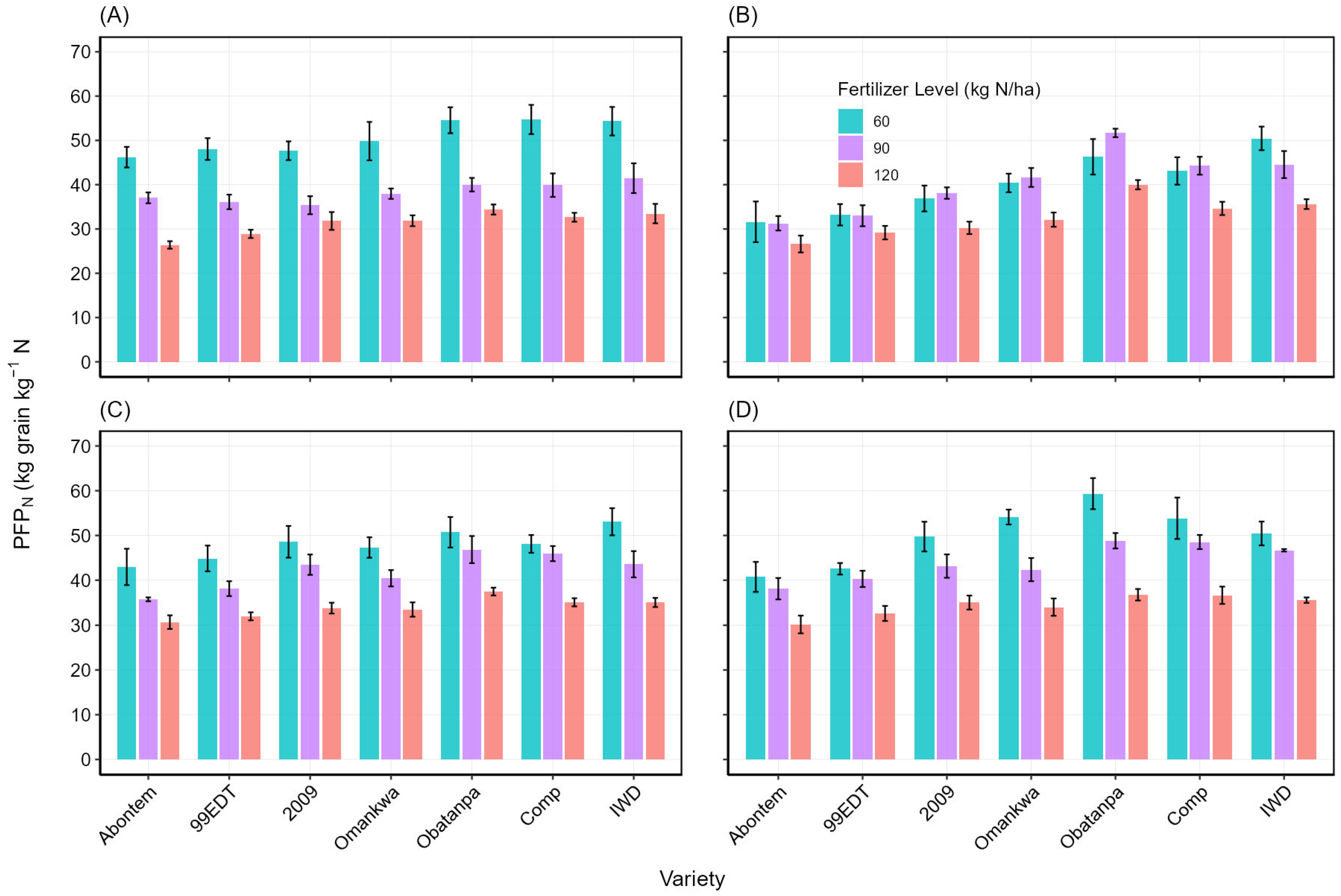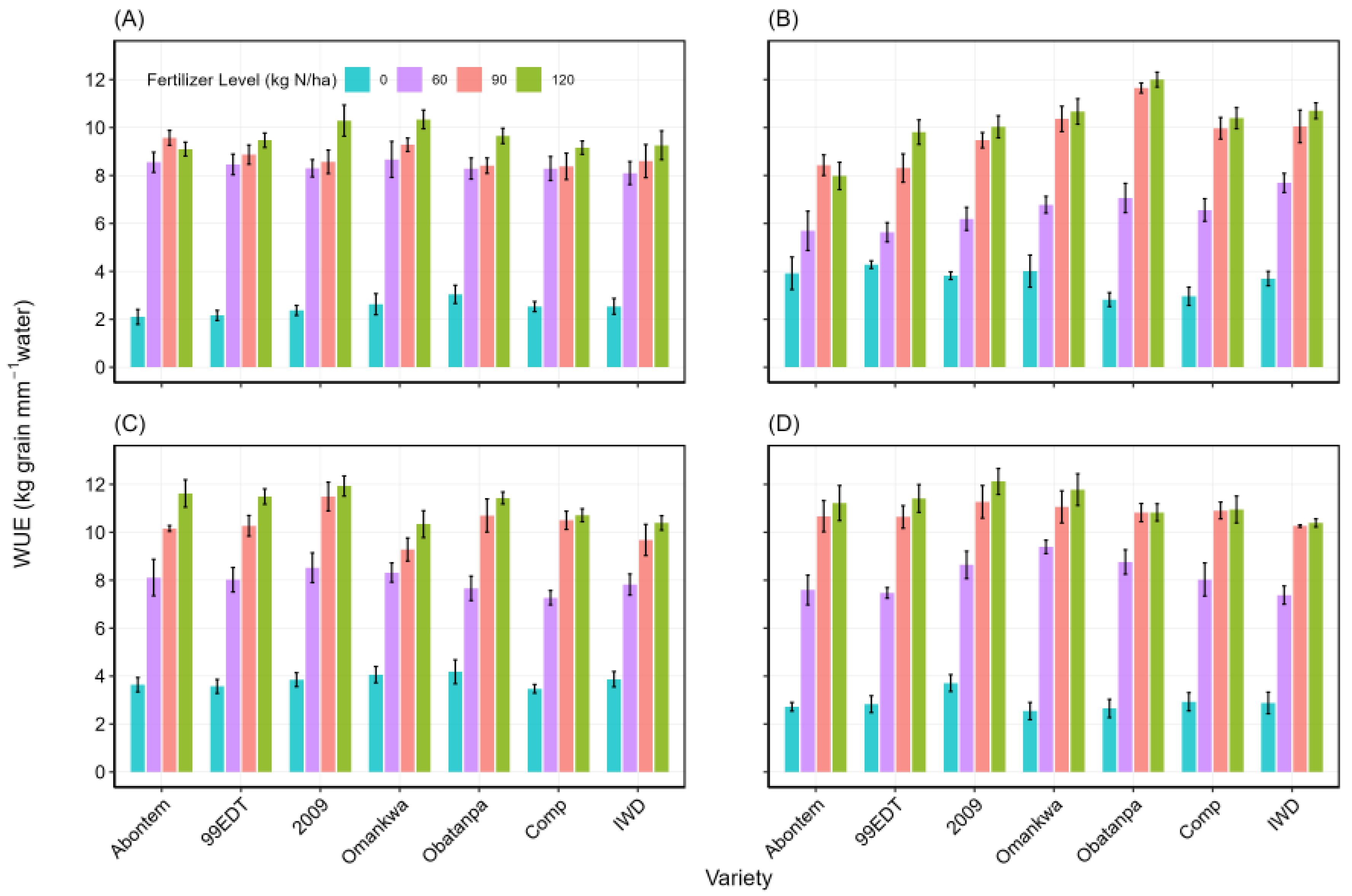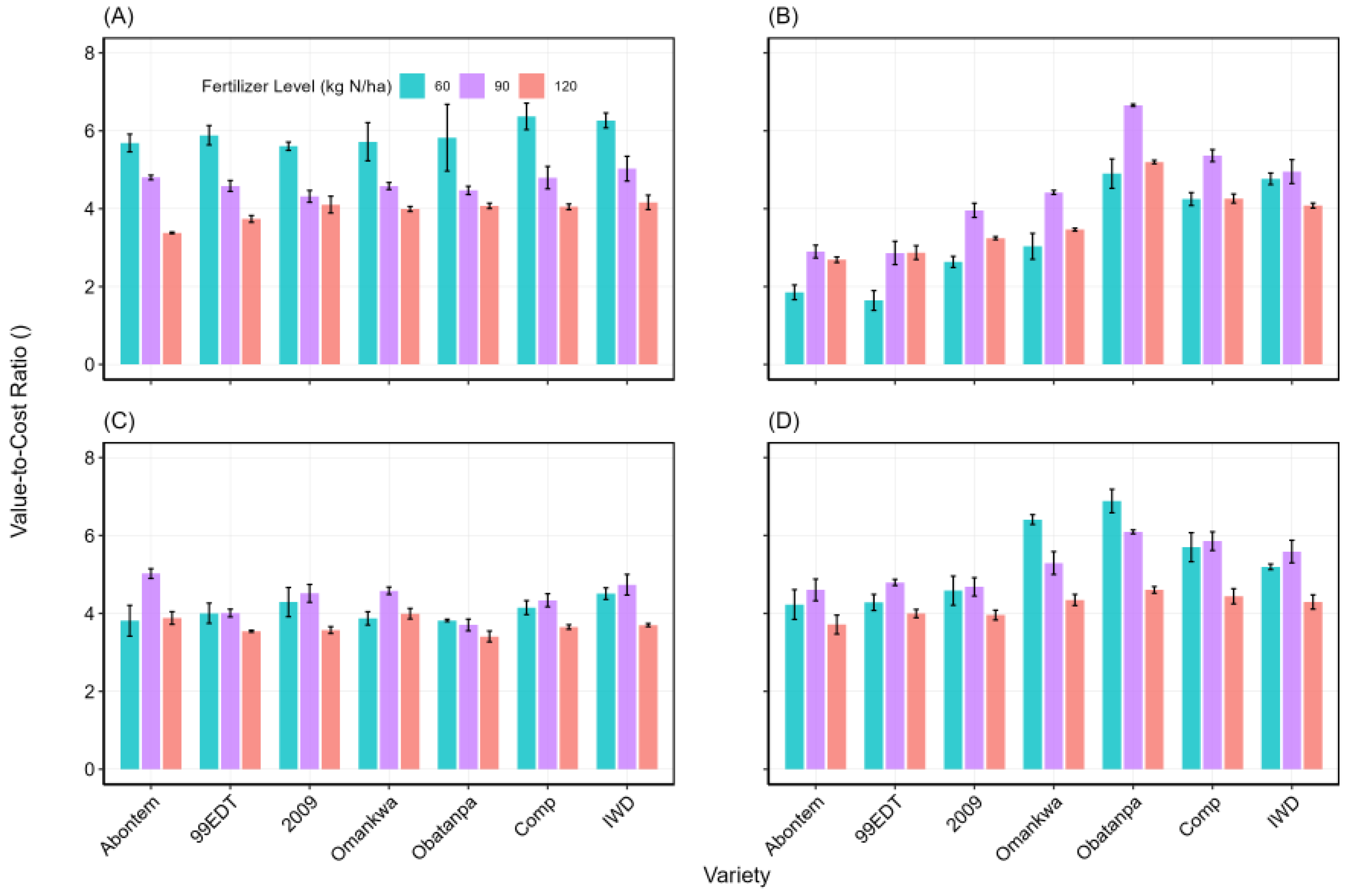1. Introduction
The demand for food is projected to rise by 60% by 2050 over the 2005/2007 baseline worldwide. This will further increase the global food security challenges, with the demand from Sub-Saharan Africa (SSA) expected to exceed the world target due to the relatively high population growth rate and low crop productivity [
1].
Maize is an important staple crop in SSA and many countries worldwide. Together with rice and wheat, they constitute two-thirds of the world’s food group and are relied on by more than 4 billion people as a source of food and livelihood. In Africa, it feeds over 300 million people and accounts for up to 50% of the caloric intake of its people and, hence, is described as a food security crop. The per capita consumption is high in Africa and ranges from 52 to 450 g/person/day compared to 50 to 267 g/person/day in Latin America [
2].
Despite the heavy reliance on maize as a major source of calories and livelihood for a significant number of people, its productivity across SSA remains low (2100 kg ha
−1), well below the world average of 5750 kg ha
−1 [
3]. The major constraints that limit the productivity of maize in SSA and, for that matter, Ghana, include low soil fertility coupled with low use of fertilizers, over-reliance on weather, which is becoming increasingly erratic, pests and diseases, use of inappropriate genetic materials, and other socio-economic factors. These contribute to a wide yield gap in maize production that has been reported in the literature [
1,
4], and with the demand for maize in SSA expected to triple [
1], it is crucial to close the significant yield gaps on farmers’ fields and bridge the disparity between current low yields and potential yields. The application of inorganic fertilizers significantly improves yields; however, their use is limited in SSA. Reports indicate that average application rates of nitrogen, a macronutrient required by crops such as maize in large quantities for optimal crop productivity, are less than 15 kg N ha
−1 yr
−1, which is insufficient to meet crop nutrient demands and, hence, limits crop yields and further exacerbates soil nutrient depletion [
5]. These application rates of nitrogen fertilizer are rather low compared to those applied (about 170 kg N ha
−1) in other places such as China [
6].
Important factors that deter farmers from patronizing the use of fertilizers are the high cost of fertilizer, low nutrient use efficiency, and variable yield response due to erratic rainfall distributions. Studies have indicated that farmers in SSA face low nutrient efficiencies and poor crop responses to fertilizers across various soil types. The situation in Ghana is similar to that in other locations in SSA [
7]. For instance, many studies [
8,
9,
10] have reported low nitrogen use efficiencies in maize in the northern part of Ghana. In certain locations, the risk of non-responsiveness is particularly high due to variations in soil organic matter [
11], leading to high input costs and potentially reducing farmers’ willingness to invest in fertilizers [
12]. These findings further emphasize the impact of location-specific variations in soil factors, such as mineralogy and parent material composition, which influence nutrient use efficiency and inorganic nitrogen fertilizer responsiveness across the region. Some studies have recommended inorganic nitrogen fertilizer application rates between 60 and 90 kg N ha
−1 with a wide range of nitrogen use efficiencies in northern Ghana [
9].
Genotypic differences also play a key role in nitrogen use efficiency. For instance, morphological and physiological traits like root architecture, leaf area, biomass distribution, photosynthetic efficiency, and nutrient remobilization influence nitrogen uptake and utilization [
13,
14]. Additionally, phenological factors such as maturity class, flowering synchrony, and grain-filling period affect nutrient partitioning [
15]. Thus, matching varieties to nitrogen application is important for optimizing nitrogen use efficiency and improving crop productivity.
Though many studies have reported on maize yield in response to nitrogen fertilization, there is inadequate information on how the response to nitrogen fertilizer is influenced by the maturity class of maize in Ghana. Thus, we hypothesize that maize varieties with varying maturity periods would respond differently to nitrogen fertilization, both in terms of agronomic and economic performance. Thus, the study aims to assess the response of different maize varieties with varying maturity classes to nitrogen fertilization at multiple locations to assess their nitrogen use efficiency, water use efficiency and the economic feasibility.
4. Discussion
Nitrogen is an important nutrient required by plants for optimum growth and yield. It is, however, the most limiting nutrient in soils in SSA and, for that matter, in Ghana, and the response of maize to its application is variable. As observed in this study, other studies [
22,
23,
24] have also reported significant yield responses of maize varieties to N fertilization. For instance, Tahiru et al. [
25] reported yield increases between 84 and 90% when nitrogen fertilizer was applied to maize in the northern region of Ghana. Generally, the rate of increase in yield was not significant beyond 90 kg N ha
−1, implying that 90 kg N ha
−1 is the optimal agronomic fertilizer application rate for these locations. This is within the 60–120 kg N ha
−1 rate reported for northern Ghana [
26] as the recommendation for maize production in the northern sector of Ghana. Atakora et al. [
27] also reported 60 kg N ha
−1 as the recommended rate for smallholders in the northern region of Ghana, which is lower than our findings. The higher optimum rate of N fertilization in our study can be attributed to the higher (relative to those used by most smallholders) fertility status of the soils used for this experiment, with soil depths beyond 75 cm compared to much lower soil depths that characterize most farmers’ fields [
28]. Additionally, the study was a researcher-managed experiment that ensured appropriate management practices, such as timing of fertilizer application and optimal planting density, were undertaken, whereas smallholder fields are often not optimally managed, with reports demonstrating double the responsiveness to nutrient application compared to farmers’ fields [
12]. It would be beneficial, therefore, to replicate this work on poorly managed farmers’ fields to gain a better understanding of the fertilizer response.
It is also interesting to note that grain yield response to N fertilization varied with the maturation duration of the variety. The extra-early varieties had the lowest yield response, while the intermediate varieties produced the highest grain yield in response to nitrogen fertilization. This is similar to results obtained by Aigbe et al. [
29], who found that yields of late and intermediate maize varieties outperformed early and extra-early varieties when grown in a rainforest ecology. The differences in the responses of maize varieties to nitrogen fertilizer could be attributed to differences in nutrient uptake and use efficiencies [
30]. Van Grinsven et al. [
31] explained that the varied yield response is a reflection of the differences in the mechanisms by which crops intercept and utilize the applied nitrogen. Additionally, the longer the crops remain on the field, the more resources (such as nutrients and water) they can take up to enhance their growth and yield, and hence their nutrient use efficiency. Thus, the rate of yield gain per unit of nitrogen fertilization was higher for the longer-maturity varieties, making them more efficient in the use of the applied nitrogen. In contrast, short-duration varieties may not allow sufficient time for nutrient uptake, particularly in nutrient-depleted soils, as reflected in the limited yield gains observed [
32]. Nevertheless, short-duration maize varieties remain crucial in drought-prone regions, providing farmers with a food security buffer under challenging environmental conditions [
33].
Under no fertilization treatments, varietal differences were suppressed and only became apparent at higher N levels. Generally, yield gains were high at 60 kg N ha
−1, but they declined beyond 90 kg N ha
−1. This is contrary to many studies that report significant yield increases even beyond 150 kg N ha
−1, suggesting that other yield-limiting factors may have reduced the response of maize to a higher level of fertilization in this study. In a meta-analysis to evaluate the global factors influencing the N fertilizer response of wheat, climatic conditions and soil properties were identified to play a key role in the response of wheat to N [
34].
As with grain yield, the efficiency of nutrient use was higher in the higher-maturity class varieties compared to the shorter-maturity ones. The range of
AEN of the varieties was largely above the 24 kg
−1 grain kg N
−1 fertilizer average reported for cereals in Africa [
35], falling within those reported for well-managed systems and much above those reported for maize-growing zones in Nigeria. The
AEN obtained in this study were within the range of 15 to 30 kg grain kg
−1 N reported by Fixen et al. [
35], suggesting the experiments were well managed and conducted on soils with recommended phosphorus and Potassium applied.
The rate of yield response to nitrogen fertilization varied among the varieties and locations and was similar (19 to 31 kg grains per kg N applied) to those reported by Ragasa & Chapoto [
36], who reported statistically significant yield response of between 22 and 26 kg increase in maize yield in response to a kg of inorganic fertilizer application for Ghana. This falls within the range of 11 to 40 kg of maize grain per kg of inorganic N fertilizer applied. The higher range reported in this study is attributed to the different maturity classes of maize varieties used, each with its unique yield potential.
Water use efficiency also increased as nitrogen levels increased, and the performance gaps between varieties became more pronounced, with some varieties demonstrating not only higher yield potential but superior water use efficiency as well. This suggests that improved maize varieties require sufficient nitrogen input to optimize resource uptake and maximize productivity. Hence, fertilizer application is crucial in revealing varietal advantages that may remain unrealized under nutrient-deficient conditions.
Additionally, the variations in water use efficiency across the four study locations highlight the significant influence of environmental factors on maize production. Differences in rainfall patterns, soil properties, and evapotranspiration at these sites played a key role in shaping water use efficiency [
37], making location-specific responses evident. These findings emphasize the importance of tailoring fertilizer recommendations to each agroecological zone to optimize water use efficiency and maize productivity. This underscores the need for site-specific management strategies that consider both environmental conditions and maize variety characteristics.
As in this study, many others have reported high profitability from inorganic fertilizer use in maize production in Ghana [
8,
36]. Generally, the VCR was above 2, a threshold set for risk-averse farmers to mitigate yield uncertainties, particularly associated with smallholder production systems where crop production is mainly rainfed. In spite of the high profitability presented in this study, the patronage of inorganic fertilizers for maize production remains low. Farmers who intend to sell their crops for cash are more likely to invest resources in fertilizers and other resources like irrigation, which serves as a risk-reducing strategy. Despite the benefits of nitrogen fertilization, there are key challenges that limit its widespread adoption, prominent among which is the lack of access to financial support to invest in farming, access to markets to sell produce, overbearing influences of market women who dictate unfair prices, and generally poor infrastructure in farming communities. A limitation of this study is the single-season nature of the experiments, in spite of the fact that they were conducted in 4 different locations. Thus, the effect of inter-annual variability weather, particularly rainfall, and how it impacts the response to nitrogen fertilization was not adequately captured. Future research should aim at exploring the effect of climate variability and integrated soil fertility management practices to provide a holistic approach integrating agronomic, economic, and environmental considerations while closing the maize yield gaps. This will be key to sustaining maize production, improving farmer livelihoods, and strengthening food security.
5. Conclusions
In this study, inorganic fertilizer significantly influenced the grain yield of all seven varieties of maize at all the locations, reinforcing the critical role of nitrogen fertilization in improving maize productivity, particularly in smallholder farming systems where soil fertility depletion remains a key constraint.
Intermediate maize varieties exhibited better AEN, PFPN, and WUE than extra-early varieties, with their full potential realized only under an adequate nitrogen supply. This demonstrates that maize varieties exhibit varying responses to nitrogen application, with variations in grain yield, nitrogen use efficiency (AEN), and economic performance across multiple locations, indicating that genotype-by-environment interactions significantly influence nutrient uptake and crop response to fertilizers. While the results indicate that nitrogen application can be profitable, the magnitude of returns depends on location (rainfall distribution, soil conditions) and maize variety, which emphasizes the importance of site-specific recommendations to maximize the value-cost ratio (VCR) of fertilizer investments.
Future research aimed at exploring the combined use of organic and inorganic fertilizers while accounting for the long-term effect of climate variability and soil health will provide a holistic approach integrating agronomic, economic, and environmental considerations while closing the maize yield gaps will be key to enhancing sustainable maize production, improving farmer livelihoods, and strengthening food security.
